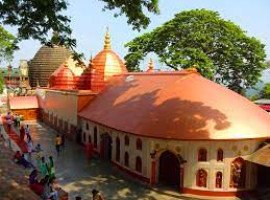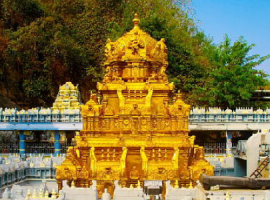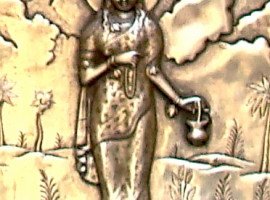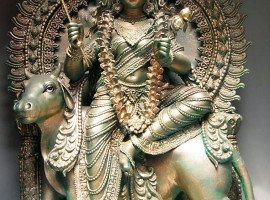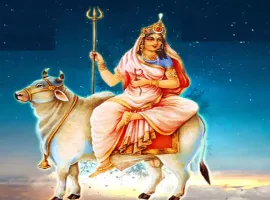Navratri Day-3 : Chandraghanta Devi
One of the nine incarnations of the Hindu goddess Durga, Chandraghanta is revered during the Navratri festival. The words Chandra (moon) and Ghanta (bell) are the origins of her name, Chandraghanta. She receives her name from a bell in the shape of the moon that is depicted on her forehead.
Arulmigu Meenakshi Sundaraswarar Temple, Madurai
Meenakshi Amman Temple, also known as Meenakshi Temple or Meenakshi Sundareswarar Temple, is a temple complex in Madurai, Tamil Nadu state, India. It is believed to have been constructed during the 16th and 17th centuries, while its initial construction dates to the fourth century CE. Hindu mythology states that the god Shiva traveled to Madurai in the person of Sundareswarar to wed Meenakshi, the Pandya king's daughter, who was a manifestation of the goddess Parvati. They have a temple at Meenakshi Amman devoted to their union.
Kamakhya Devi Temple, Guwahati
One of the largest Shakti temples in the nation is the Kamakhya temple, which is 7 miles from Guwahati. This temple, which is located on the Nilachal Hills, is a significant Hindu and tantric pilgrimage site. It is also regarded as significant since it is the temple where non-Aryan groups and communities of Aryans share beliefs and practices.
Sri Durga Malleswara Swamy Varla Devasthanam, Vijayawada
A Hindu temple honoring Kanaka Durga is known as Sri Kanaka Durgamma Devasthanam or Kanaka Durga Temple. The god in this temple is also known as Kanaka Durga in popular culture. The temple is situated on the Indrakeeladri Hills by the Krishna River in Vijayawada, Andhra Pradesh, India. The Kanaka Durga on the Indrakeelaadri is mentioned in the Kaalika Purana, Durgaa Sapthashati, and other works of Vedic literature. The deity is characterized as Swayambhu, (self-manifested) in Triteeya Kalpa.
Most Popular Mantras and Stotras to Brahmacharini
Brahmacharini is the second form of the Hindu goddess Durga, worshipped during the Navratri festival. She is known for her austerity and dedication to spiritual practice. Brahmacharini is depicted as a young woman dressed in white, carrying a kamandalu (water pot) and a japa mala (rosary). She is the embodiment of tapasya (austerity) and sadhana (spiritual practice).
Navratri 2023 Day 2 : Maa Brahmacharini
Navaratri is a nine-day festival celebrated by Hindus with great enthusiasm. The second day of Navratri is dedicated to Goddess Brahmacharini, who is known for her penance and is believed to bless her devotees with power, strength, wisdom, and knowledge. To worship her, devotees wake up early, bathe, light a ghee diya, offer flowers and sweets, chant mantras, and recite Durga Saptashati Path. The story of Maa Brahmacharini involves her strict penance to marry Lord Shiva.
Most popular mantras and stotras to Shailputri
Shailputri is the first of the nine forms of the Hindu goddess Durga, worshipped during the Navratri festival. She is also known as Sati, Aparna, and Hemavati. Shailputri is depicted as a young woman riding a bull and carrying a trident in her hand. She is the daughter of King Himavat and Queen Mena, and is considered to be the embodiment of the power of the mountains.
Temples to visit during Navratri
The yearly Hindu festival of Navaratri is celebrated in honor of the goddess Durga, a manifestation of the supreme goddess Adi Parashakti. It occurs twice, once in the months of Ashvin (September–October) and once in the month of Chaitra (March–April on the Gregorian calendar), and lasts for nine nights (and ten days). In various areas of the Hindu Indian cultural realm, it is commemorated for diverse causes and observed and celebrated in varied ways.There are four seasonal Navaratris, according to theory. In reality, it is Sharada Navaratri, an autumn celebration that takes place after the monsoon season.
Famous Shailputri temples in India
Famous Shailputri temples in India Shailputri is the first of the nine forms of the Hindu goddess Durga, worshipped during the Navratri festival. She is also known as Sati, Aparna, and Hemavati. Shailputri is depicted as a young woman riding a bull and carrying a trident in her hand. She is the daughter of King Himavat and Queen Mena, and is considered to be the embodiment of the power of the mountains.
Goddess Shailaputri
Today is October 15. This is the day when Durga came to earth to destroy evil. For the next nine days, worship is done to Navadurga. That is Navratri. Pink, the first colour, stands for Goddess Shailputri. Pink symbolizes kindness and nourishment. When her followers seek for food during difficult times, it is believed that Goddess Durga will grant their requests.


